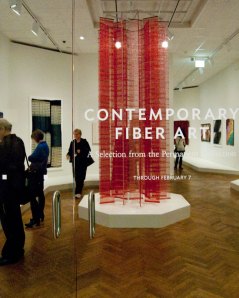A group of six influential artists from Eastern Europe, Maria Łaszkiewicz, Magdalena Abakanowicz, Luba Krejci, Ritzi Jacobi, Zofia Butrymowicz and Jolanta Owidzka will be among the 32 artists featured in Influence and Evolution: Fiber Sculpture…then and now, at browngrotta arts in Wilton Connecticut. The oldest is Maria Łaszkiewicz of Poland, born in 1892 (died 1981). She encouraged a generation of textile artists, including
Magdalena Abakanowicz (born 1930). In the catalog essay for Influence and Evolution, Ezra Shales, PhD notes that even thought she was born in the 19th century, “…Laszkiewicz was probably less weighted down by the material traditions of fiber than we would expect – and more modern for her time than she might seem to us today. She speaks global folk idioms and traditions with ease.” Magdalena Abakanowicz, who worked in Laszkiewicz’s studio, is the most well-known artist of this group, as much for her monumental figures in bronze as for the enormous weavings she created in 1960s. In creating her rebellious Abakans works, “I did not want to relate to either tapestry or sculpture,” Abakanowicz has written. “Ultimately it is the total obliteration of the utilitarian function of tapestry that fascinates me.” Luba Krejci (1925-2005) of Czechoslovakia also forged a new direction, creating figures of thread by adapting needle and bobbin lace-making techniques to create “intake,” a technique of her own making. The figures in her work are not what one would encounter in American work according to critic Janet Koplos. They are, Koplos wrote in the New Examiner in 1970, “not organic, not playful, not color studies, not romantic. They share with Eastern European fiber art a somber mood, a predominance of dark colors, a look back to classic themes and
characters, and a great drama.” The youngest of this renown group, Ritzi Jacobi (born 1941), originally of Romania participated in 11 of the prestigious Lausanne Biennials and is represented in Influence and Evolution by a newer work, created in 2000. The exhibition will also include works from the 1960s by Polish artists Zofia Butrymowicz (1904 -1987) and Jolanta Owidzka (born 1927), a colleague of Abakanowicz in Warsaw. Influence and Evolution also features 15 artists, born after 1960, who approach materials, form and technique with a sense of exploration similar to that which characterized the 60s and 70s. The exhibition opens at 3pm on April 24th. The Artists Reception and Opening is on Saturday April 25th, 1pm to 6pm. The hours for Sunday April 27th through May 3rd are 10am to 5pm. To make an appointment earlier or later, call: 203-834-0623.















